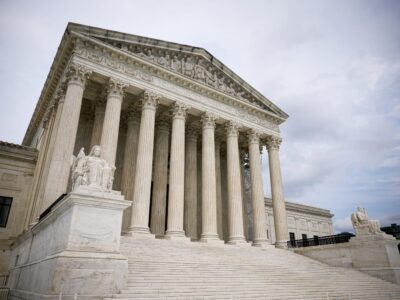200 Days and Counting: Public Lands
The potential impact of a Trump Administration on our federal public lands.
The federal government owns almost one-third of the land in the United States, primarily concentrated in the Western states. In addition, the federal government is the primary manager of the oceans off the coast of the United States (with the exception of oceans within three miles of the coastline, which are primarily under state authority). Decisions about how to manage these resources will have significant impacts on the environment today and in the future. In particular, public lands and ocean management decisions might affect, among other issues:
- Climate change, to the extent that leasing of federal lands for oil, gas, and coal production continues or increases.
- Biodiversity protection, since a significant number of endangered species have their habitat on federal lands.
- Recreation, since many federal public lands are a key destination for local, national, and international recreational users.
Federal management of the public lands is guided by a complicated legal framework. Each of the four major federal land management agencies (the National Park Service (NPS), the U.S. Forest Service (USFS), the Bureau of Land Management (BLM), and the U.S. Fish and Wildlife Service (USFWS) (which manages National Wildlife Refuges)) manages their lands under a legal framework established by Congress. Those legal frameworks (often called organic acts) set up procedures the agencies must follow and substantive standards they must comply with. In general, all the land management agencies must promulgate plans that will guide how they manage their lands over the medium-term (usually about a 10 to 15 year time frame). Plan development or updates generally must provide for public participation. The different agencies must meet different substantive standards in managing their lands. Two agencies (USFS and BLM) operate under a multiple-use standard in which they are supposed to facilitate a wide range of uses for their lands, ranging from logging to grazing, mining to oil and gas development, protection of biodiversity and other environmental resources, and outdoor recreation. NPS and USFWS are supposed to prioritize particular uses in managing their lands – conservation and public enjoyment for the parks (with a requirement that any management cannot impair park resources), and protection of wildlife and ecosystems for wildlife refuges.
For off-shore areas, the main issues relate to leasing of off-shore lands for oil and gas development under the Outer Continental Shelf Leasing Act (OCSLA). This statute also is a fairly broad balancing statute, similar to those guiding USFS and BLM.
In addition to the organic act frameworks, each agency must also comply with the National Environmental Policy Act (NEPA) when it makes important management decisions for its lands – generally this requires the agency to assess the potential environmental consequences of its decisions and publicly disclose those consequences. Finally, the Endangered Species Act (ESA) restricts the ability of agencies to take actions that might significantly harm endangered or threatened species on federal lands.
There is one more important federal land management statute: Significant portions of the federal lands have been designated by Congress as wilderness areas, and under the Wilderness Act these areas generally are off-limits to development and many forms of active management by land management agencies.
The Trump Administration has made clear that it wishes to rebalance how the federal public lands are managed, increasing development on those lands, including leasing those lands for fossil fuel development, facilitating greater off-road vehicle use, and more active management of federal lands to respond to challenges such as massive forest die-offs from climate change-facilitated beetle infestations.
How much leeway will the Administration have to pursue these options? To the extent it seeks to undo Obama Administration regulations – for instance, regulations of hydraulic fracturing development of oil and gas resources on federal public lands, or regulations of the release of methane from oil and gas development on federal public lands – the same questions that would come up in general in administrative law would come up here. Has the agency adequately supported a change in the regulations based on the factual record before it and does the change comply with the relevant legal standards? Environmental groups and other plaintiffs will be able to sue under the Administrative Procedure Act (APA) to challenge rulemaking changes they do not agree with.
On the other hand, the Administration will also be changing outcomes on the public lands through individual management decisions – whether to lease particular parcels of federal lands for oil, gas, or coal development; whether to open an area to off-road vehicle use; whether to offer a timber sale on a particular section of a National Forest. For instance, the Administration has eliminated a moratorium on coal leasing that the prior Administration put in place. Relatedly, the Administration may also seek to revise the land management plans that guide individual management decisions on the public lands. Again, lawsuits under the APA may be available to plaintiffs to challenge management decisions they disagree with.
Whether it is regulations, individual management decisions, and land management plans, a key constraint for the Administration will be the statutory framework that it is operating within. For some agencies, such as the USFS and BLM, the organic acts are broad enough that they likely do not constrain the Administration very much in what it wants to do. For NPS and the USFWS, the organic acts do have significant bite in how they constrain agency decisionmaking, and the courts have (on occasion) enforced those constraints. That is also true of the Wilderness Act for designated wilderness areas.
Thus, the impacts of the new Administration will be most felt on the multiple-use lands – National Forests and BLM lands, which make up about two-thirds of the federal public lands. Here the agency will have more leeway. Likewise, there is substantial leeway in agency decisions about whether to lease off-shore areas for oil and gas development.
But even in these areas, both NEPA and the ESA may provide significant constraints. For instance, environmental groups have been involved in significant (and sometimes controversial) litigation over USFS logging projects in National Forests, using NEPA and the ESA as their primary litigation tools. Not all of these lawsuits will succeed, but they will provide some constraints on agency action here.
Of course, not all agency decisions will be litigated in all places. Moreover, courts often tend to defer to agency interpretations and applications of statutes with ambiguous statutory language (as is true for many of these statutes) where significant expertise is required to implement the statutes (again as is true for many of these statutes). In addition, political leadership in the agencies can use internal agency guidance documents to shape how the governing statutes are interpreted and applied by agency employees. On the margins, this can make an important difference.
Another context in which the Administration can make a difference with some long-term impacts is the revision of existing land-use plans to reduce protections for environmental resources and facilitate greater development. These changes can last a while, since plans may go many years, even decades, between revisions, and all management decisions must be consistent with the relevant plan. However, land-use planning is a resource intensive process, requiring substantial public outreach, analysis, and NEPA and ESA compliance. An Administration that has asked for significant budget cuts for the land management agencies is making it hard for those plan updates to occur.
Finally, there are particular statutory systems that do seem to give substantial unilateral power to the President without much room for judicial review. Designation of national monuments under the Antiquities Act is an example of this – courts have been very deferential in reviewing Presidential proclamations creating monuments. (Whether Presidents can eliminate or reduce existing monuments is a different question, and a legal one for which I expect close and careful judicial consideration.) National monument designation creates protection for public lands from a range of development activities, and accordingly has been quite controversial. Similarly, there are provisions of OCSLA that give the President the power to set aside areas from oil and gas development.
All in all, there is substantial discretion for the Executive Branch in managing the public lands, in part because much of the decisionmaking does not require Congressional intervention. However, the relevant statutory schemes closely constrain some of the decisionmaking, and in most cases, there is at least some constraint imposed by overarching statutes such as NEPA and the ESA. And those constraints are often enforceable by courts in response to lawsuits.







Reader Comments